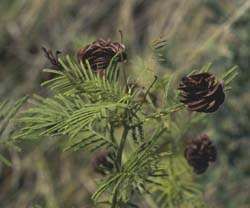Objective: Students
will be able to identify and describe prairie plant parts that show adaptation
to habitat and environmental conditions by searching the ISM's online database,
field guide, and photograph gallery of plants.
Grade levels:
Elementary and junior high
Time Required: 50 minutes
ISM Web sites:
MuseumLink Illinois Prairie, Prairie Ecosystems, Plants, Adaptations:
https://www.museum.state.il.us/muslink/prairie/htmls/eco_adapt.html
Field Guide: https://www.museum.state.il.us/muslink/prairie/htmls/eco_fieldguide.html
ISM Botany Department Herbarium Database and Photograph Gallery: https://www.museum.state.il.us/ismdepts/botany/collections/
Students will
read the Adaptations section of the Prairie Web module, and read about
plant adaptations in their science text or other science materials in
the curriculum. Using real plants and field guide examples, the teacher
will guide the students through descriptions of plant parts and how
the parts are adapted to the soil, water, and temperature conditions
in which they grow.
Motivation: Class
discussion of adaptations, using real plants, if possible, from nursery or
school garden outside to identify and discuss physical adaptations plants
have that help them survive in their environment.
Sample Discussion
Questions:
1. What is the size, shape, surface texture, and location of the leaves (soft,
fleshy, dry, hard, thin, thick, narrow, round, at the base, along the stems)?
2. How does this relate to water retention and survival in drought or fire?
3. What type of flowers does the plant display (many small blooms, clusters,
large blossoms)?
4. Does the stalk bloom from the bottom up or from the top down?
5. Do the flowers attract insects? How?
6. What kind of stems does the plant have (height, thickness, surface texture)?
How does this help the plant survive and reproduce?
7. How are the seeds stored and dispersed in the plant (if possible to see
at this time of year)? How does this promote diversity?
Materials:
prairie plants (either in the field or in pots)
field guide (online or print)
worksheet
pencil
Procedure:
Students will go to a prairie, or use plants in class or in a school
or home garden. Individual students or pairs of students work on each
worksheet. In turn, look at each plant, identify it, write its name,
draw a sketch from life that shows its adaptive parts, and write a short
description of its adaptive parts.
Example:

Illinois Bundle Flower
Habitat: It lives in dry-mesic soil.
Adaptations:
Leaves are small and they close up, which lets them retain water.
Seeds are hard, pointed (can catch hold of passing creatures), and curved
(can move farther in air and drill down into the soil as they land)
Assessment:
Students present their findings to the class (at least one per student) orally
or visually. Whole class discussion or small group discussion can help those
whose results are incomplete. Each student should be able to find one adaptation
on each plant and describe it using vocabulary learned in class, and in the
online descriptions, and in their own words.
Illinois State Board
of Education Goals Addressed:
Science: Goal 12.B: Early elementary through junior high: Know and
apply concepts that describe how living things interact with one another and
with their environment.
12.B.2b Identify physical features of plants and animals that help
them live in different environments (e.g., specialized teeth for eating certain
foods, thorns for protection, insulation for cold temperature).
Extension
for high school or accelerated:12.B.5b Compare and predict how life
forms can adapt to changes in the environment by applying concepts of change
and constancy (e.g., variations within a population increase the likelihood
of survival under new conditions).
Plant Adaptation
Worksheet
Name__________________________
Draw a line drawing
of your plant here. Include all the major parts of the plant. Label
the parts of the plant that you think are especially adapted for prairie
habitat. For each part labeled, write a short description below that
tells how this adaptation helps the plant survive better.

